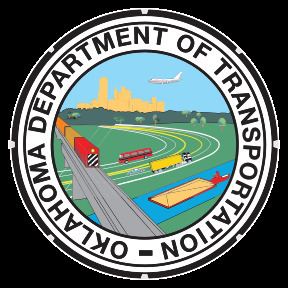Formed 1976 Founded 1976 | Number of employees 2,322 Annual budget 1.7 billion USD (FY10) | |
 | ||
Preceding agency Oklahoma Department of Highways Minister responsible Gary Ridley, Secretary of Transportation Agency executive Mike Patterson, Executive Director Parent agency Oklahoma Transportation Commission Website Oklahoma Department of Transportation Profiles | ||
Oklahoma department of transportation director gary ridley testifies at congressional hearing
The Oklahoma Department of Transportation (ODOT) is an agency of the government of Oklahoma responsible for the construction, maintenance, and regulation the use of the state's transportation infrastructure. Under the leadership of the Oklahoma Secretary of Transportation, the Department maintains public infrastructure that includes rail lines, state highways, state seaports and state airports. Along with the Oklahoma Turnpike Authority, the Department is the primary infrastructure construction and maintenance agency of the State.
Contents
- Oklahoma department of transportation director gary ridley testifies at congressional hearing
- History
- Overview
- Leadership
- Organization
- Staffing
- Classifications
- Budget
- Supporting agencies
- References
ODOT is led by a State Transportation Commission, composed of nine members appointed by the Governor of Oklahoma with the approval of the Oklahoma Senate. The Commission in turn appoints a Director, who serves as the executive head of the Department. Gary Ridley serves as the Secretary of Transportation, as appointed by Governor Brad Henry in 2009 and reappointed by Governor Mary Fallin in 2011.
The Department was created in 1976 during the term of Governor David L. Boren. It superseded the Department of Highways, which was established in 1911.
The Department of Transportation's mission statement is "The mission of the Oklahoma Department of Transportation is to provide a safe, economical and effective transportation network for the people, commerce and communities of Oklahoma."
History
The predecessor agency to ODOT was the Department of Highways, which began operations in 1911, four years after Oklahoma statehood. The Department of Highways, consisting of four employees, was given an initial budget of $3,700. The state's first 29 numbered highways were commissioned on August 29, 1924. As of May 1, 1926, the state highway system consisted of 3,682 miles (5,926 km) of graded dirt roads (72% of the system), 832 miles (1,339 km) of gravel roads (16%), and 634 miles (1,020 km) of paved roads, for a total system length of 5,148 miles (8,285 km). By March 1, 1930, the department name had been modified slightly to simply the Oklahoma Department of Highways.
In 1976, the Oklahoma Legislature restructured the Department of Highways as an overall coordinating agency for the state’s highways, railways and waterways and renamed to the Oklahoma Department of Transportation.
Overview
The Department of Transportation is primarily funded by motor vehicle fuel taxes, legislative appropriations, and a return of federal matching dollars from the Federal Highway Trust Fund. ODOT’s annual budget of both federal and state funds is applied to highway construction and maintenance activities, railways, waterways, public rural transit programs and administration statewide. While the primary business is construction and maintenance of the state’s highways, the agency also promotes intermodal transportation such as railroads and waterways.
As of 2015, ODOT is responsible for the maintenance of 6,800 bridges and 31,000 lane-miles (49,890 lane-km) of road throughout the state. Of this, over 12,000 lane-miles (19,312 lane-km) are Interstate highways. In 2014, ODOT assessed approximately 372 of its bridges as being structurally deficient. This is compared to 1,168 structurally deficient bridges in 2004.
The Department also maintains 200 miles (320 km) of state-owned railway, which are operated through leases with railroad companies. administers the Federal Highway Administration’s Grade Crossing Safety Program which provides funding to make safety improvements to Oklahoma’s nearly 3800 at-grade public railway/road intersections, manages the Amtrak Heartland Flyer passenger rail service in partnership with the Texas Department of Transportation.
Leadership
The agency is under the supervision of the Oklahoma Secretary of Transportation. Under Governor of Oklahoma Mary Fallin, Gary Ridley is serving as the Cabinet secretary.
The Oklahoma Transportation Commission is the governing body of the state transportation department. The Governor of Oklahoma, with the approval of the Oklahoma Senate, appoints the members of the eight-member commission. It is the duty of the commission to establish agency policies and to appoint the agency director. The members each represent one of the eight geographic districts corresponding with the agency's eight field divisions. The governor serves as an ex officio member of the commission, but may only vote to break a tie.
The current members of the Oklahoma Transportation Commission are as follows:
Organization
Staffing
The Transportation Department, with an annual budget of well over $1 billion, is one of the largest employers of Oklahoma state government. For fiscal year 2009, the Department was authorized 2488 full-time employees.
Classifications
The Transportation Department's employees are divided within the following major job classifications:
Budget
The Department of Transportation is a non-appropriated State agency. This means that is annual operating and program budget is not dependent upon yearly appropriations from the Oklahoma Legislature. The Legislature, through the enactment of State law, has provided the Department with a direct stream of revenue, with all such revenue automatically deposited into the State Transportation Fund. One of primary revenue sources for the Department is the State's sales tax on gasoline and diesel motor fuels. Those taxes constitute roughly one-third of the Department's total budget. Grants under the Federal-aid Highway Program of the Federal Highway Administration equal almost sixty percent of the budget. The remaining ten percent from the sale of State bonds for the construction of State roads and bridges.
The Department's annual budget is divided between two major areas: Departmental Administration ($413 million for FY2011) and Capital Improvements ($1.3 billion for FY2011). The first is used for the operation of the Department, such paying employee salaries and utilities, and the second is used for the construction and maintenance of transportation systems across the State.
